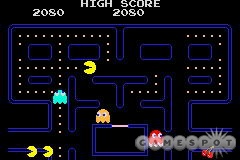


The first, Namco Bandai Studios Singapore, is Namco Bandai's "leading development center" in Asia and develops game content for the Asia Pacific market. In March 2013, Namco Bandai Games established two new game studios. It comprises approximately 1,000 employees, who were already part of Namco Bandai. The new company was spurred by Namco Bandai's interest in faster development times and tighter cohesion between disparate development teams. On 2 April 2012, Namco Bandai Games spun off its development operations into a new company called Namco Bandai Studios. In early 2011, Namco Networks was absorbed into Namco Bandai Games America, effectively consolidating Namco Bandai's American console, handheld, and mobile video game development operations. They created 100 versions of the ad as the game consists of 100 chapters.
#Namco museum 50th anniversary collection tv
In 2010, Namco Bandai Games entered the Guinness World Records as the company that released the most TV commercials for the same product, a Nintendo DS game called Solatorobo: Red the Hunter. Following Afro, early press materials indicated that Dead to Rights: Retribution and Splatterhouse would also be released under the Surge label, but neither game ultimately did both were released with a retro Namco label instead to reflect the series' legacy, the Surge branding would be phased out following the release of Afro Samurai. The new label was an attempt at creating a separate identity for the company, aimed at a Western audience desiring more mature themes in-game content. Just prior to the release of Afro Samurai at the end of 2008, the company announced the Surge publishing label. On 1 April 2009, Bandai Networks, Namco Bandai's mobile phone business, was dissolved and absorbed into Namco Bandai Games. On 1 April 2008, Banpresto's video game operations were absorbed by Namco Bandai Games. Earlier on 26 January, Namco Hometek and Bandai Games merged to form Namco Bandai Games America, the North American division. Both companies worked independently under the newly formed Bandai Namco Holdings until March 31, 2006, when their video game operations were merged to form Namco Bandai Games. īoth companies in a joint statement cited Japan's decreasing birth rates and advancements in technology as the reason for the merge, and to increase their relevance to newer audiences. Bandai purchased Namco for US$1.7 billion, with Namco receiving 43 percent of shares and Bandai receiving the other 57 percent. The merge was finalized on 25 September, creating the third-largest video game publisher in Japan by revenue. In February 2005, in the wake of their 50th anniversary, Namco announced their intent to merge with Bandai to form Bandai Namco Holdings. It is the core publishing and development area of the Bandai Namco Group's "Content Strategic Business Unit" (Content SBU), and the main video game branch of Bandai Namco Holdings.īandai Namco's former headquarters in Shinagawa, Tokyo. The company also owns the licenses to several Japanese media franchises, such as Shonen Jump, Kamen Rider, Super Sentai, Sword Art Online, and the Ultra Series. As of March 2020, it is the third-largest game company in Japan in terms of revenue and market capitalization, after Sony Interactive Entertainment and Nintendo, ahead of Square Enix, Konami, and Sega. Namco Bandai Games was renamed Bandai Namco Games in 2014 and again to Bandai Namco Entertainment a year later.īandai Namco Entertainment owns several multi-million video game franchises, including Pac-Man, Tekken, Gundam, Soulcalibur, Tales, Ace Combat, Taiko no Tatsujin, The Idolmaster and Dark Souls, Pac-Man himself serves as the official mascot of the company. Namco Bandai Games absorbed Banpresto's video game division in 2008 and dissolved Bandai Networks in 2009.ĭevelopment operations were spun off into a new company in 2012, Namco Bandai Studios (now called Bandai Namco Studios), to help create faster development time and tighter cohesion between development teams. Originally known as Namco Bandai Games, it merged Bandai Games and Namco Networks in January to create Namco Bandai Games America. It is a wholly-owned subsidiary of Bandai Namco Holdings, an entertainment conglomerate.īandai Namco Entertainment was formed on 31 March 2006, following a corporate merge between Namco and Bandai on 29 September of the previous year. Its international branches, Bandai Namco Entertainment America and Bandai Namco Entertainment Europe, are respectively headquartered in Santa Clara, California and Lyon, France. is a Japanese multinational video game publisher headquartered in Minato-ku, Tokyo.


 0 kommentar(er)
0 kommentar(er)
